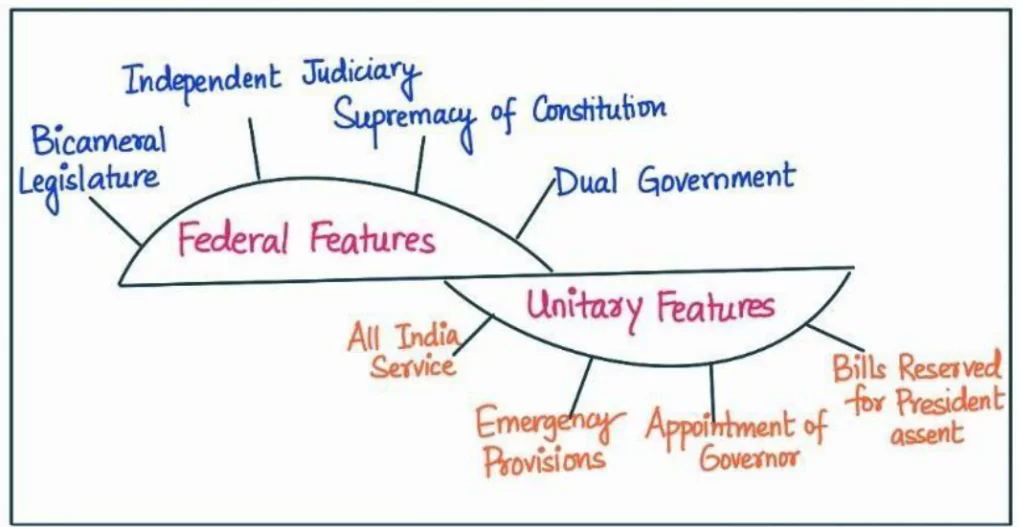Answer:
|
How to approach the question
- Introduction:
- Write about the Indian union.
- Body
- Highlight the federal features of Indian polity.
- Write about the unitary features of Indian polity.
- Conclusion
- Conclude by highlighting your views.
|
Introduction
The Indian Union (Article 1), is characterized as a Union of states rather than a Federation of states. This distinction sets the stage for examining the nature of the Indian political system. Indian federation leans towards a unitary state with federal characteristics or a federal state with predominant unitary features.
Federal Features of Indian constitution:
- Dual Polity: The Indian Union exhibits a dual polity, where both the central government and state governments possess independent authority.
- Written Constitution: The Constitution of India is a written document that delineates the powers and functions of the central and state governments.
- Division of Powers: The Seventh Schedule of the Constitution outlines the distribution of powers between the centre and the states through the Union List, State List, and Concurrent List.
- Supremacy of the Constitution: The Constitution is the supreme law of the land, providing a framework for governance and protecting the rights and freedoms of citizens.
- Rigid Constitution: The Constitution can only be amended through specific federal provisions, ensuring a certain level of stability and permanence.
- Independent Judiciary: The judiciary acts as an impartial arbiter and interprets the Constitution to resolve disputes between the centre and the states.
- Bicameralism: The Indian Parliament consists of two houses, the Lok Sabha and the Rajya Sabha, representing the interests of both the states and the centre.
Unitary Features of Indian constitution:
- Strong Centre: The centre holds significant power and authority over certain subjects.
- Union List and Residuary Power: The Union List contains more subjects compared to the State List, and the residuary power lies with the central government.
 Article 3: The Constitution provides for the alteration of state boundaries, indicating that states are not inviolable entities.
Article 3: The Constitution provides for the alteration of state boundaries, indicating that states are not inviolable entities.- Single Constitution: Both the centre and the states operate under a single constitution.
- Flexible Amending Procedure: The Constitution allows for a relatively easier process of amending most provisions.
- Unequal Representation: States are not equally represented in the Rajya Sabha, the upper house of Parliament.
- Emergency Provisions: Articles 352, 356, and 360 empower the centre to take control of the states under certain circumstances.
The Indian Union has more unitary features compared to federal features. However, this does not violate the basic federal principle of a dual polity.
- The centralizing tendency is considered an exception rather than a rule, as affirmed by the Supreme Court in the SR Bommai case.
- The Indian federalism model promotes a cooperative and competitive approach.
- Initiatives like GST and the inter-state council showcase this cooperative and competitive federalism. This unique federal structure allows states to freely share revenue, ideas, and power with the centre.
In conclusion, the Indian Union can be characterized as a unitary state with subsidiary federal features. The Indian federalism model strikes a balance between centralism and regional autonomy, fostering cooperative and competitive federalism in a way that is distinctively Indian.
To get PDF version, Please click on "Print PDF" button.
 Article 3: The Constitution provides for the alteration of state boundaries, indicating that states are not inviolable entities.
Article 3: The Constitution provides for the alteration of state boundaries, indicating that states are not inviolable entities.
https://uploads.disquscdn.com/images/7e39a1144191e515586a31b0fce4d7073da73956c3bf7e90fc38f156aba5fd06.jpg https://uploads.disquscdn.com/images/56c0ca42eead9d437964a2112260c30d7993a281ce688eaa1cd98d87a010a3e0.jpg
https://uploads.disquscdn.com/images/970ab2f7f84a0b2731d656da5b5725c9cef33655f30bb2ffebcab7f8060f73e8.jpg https://uploads.disquscdn.com/images/ad4108925c7dc8a281adce66aae6a34b9bdc376608542b28e286d42ead920e06.jpg